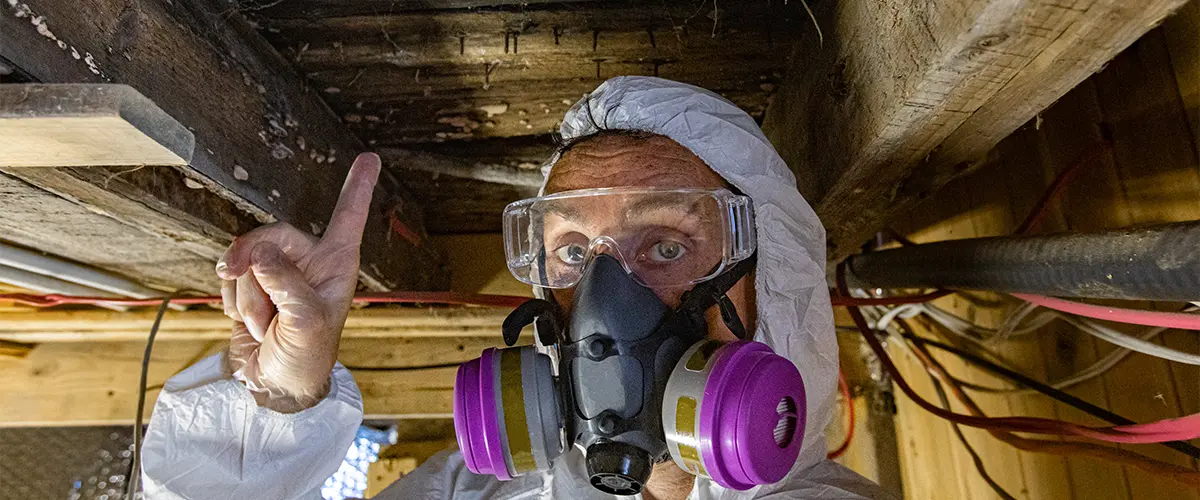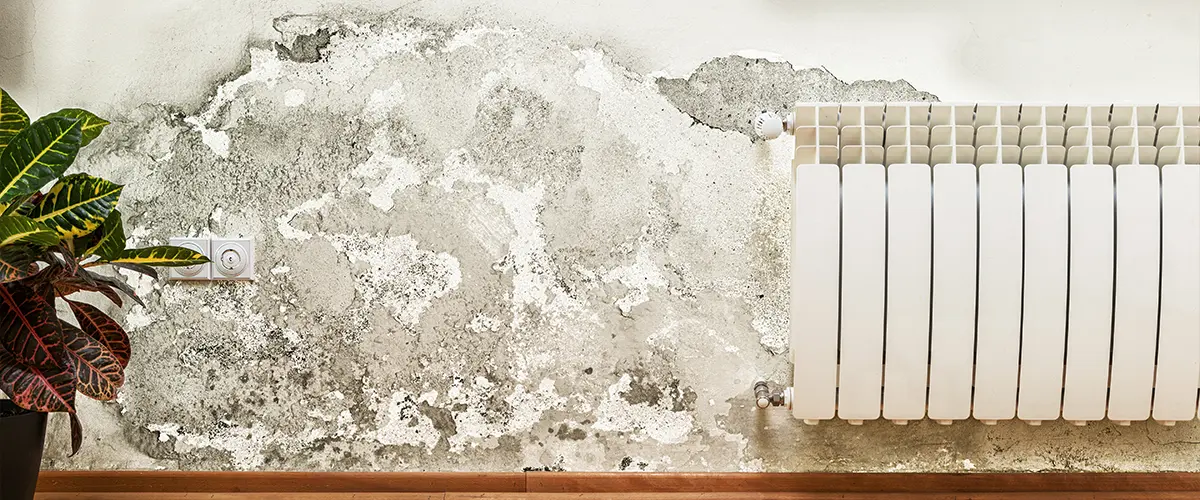Worst Types Of Mold In Homes In Hyattsville
Mold in your home can be a scary thought. Many types of mold are harmful, especially in Hyattsville homes. This article will guide you through the worst molds and how to handle them.
Keep reading for vital information!

The Most Dangerous Types of Mold in Homes
Stachybotrys (black mold)
Stachybotrys, often called black mold, is a toxic mold that poses serious risks to your home and health. This dangerous mold thrives in moist areas and can lead to severe allergic reactions and respiratory issues if not addressed promptly.
Black mold releases spores into the air which, when inhaled, can harm people with weakened immune systems or trigger asthma attacks.
Exposure to Stachybotrys can result in chronic coughing, sneezing, irritation to the eyes and skin, and even more severe health complications over prolonged periods.
Homeowners should be vigilant for any signs of black mold growth on walls, ceilings, or other damp surfaces. Ignoring this problem not only damages your property but also puts your family’s health at risk.
If you suspect the presence of Stachybotrys in your home, it’s crucial to seek professional mold removal services immediately.

Chaetomium
Moving from the dangers of Stachybotrys, Chaetomium emerges as another mold to watch out for in your home.
This type often grows in homes that have experienced water damage. You might find it on damp building materials or organic surfaces like wood and wallpaper.
Chaetomium starts as a white cotton-like material but turns gray to olive as it ages.
People with weakened immune systems may suffer severe allergic reactions to this mold.
Exposure can lead to skin and nail infections, posing additional health risks beyond respiratory symptoms.
Keeping your home dry and well-maintained is key to preventing its growth.
Aspergillus
Aspergillus mold thrives in homes, often found on walls, insulation, and anywhere dampness lingers. This mold family isn’t just one type; it includes several species that affect homes in Hyattsville.
Aspergillus spores float through the air indoors and outdoors — making it easy to inhale them without knowing. For people with weakened immune systems or lung diseases, these spores can cause serious health problems like allergic reactions or respiratory issues.
This type of mold sometimes appears less threatening because it doesn’t look as obvious as black mold. Yet, its ability to hide makes it particularly dangerous since homeowners might not spot an infestation early on.
Keeping your home dry and well-ventilated helps prevent its growth. Next up is Penicillium – another common invader in damp areas.
Penicillium
After learning about the dangers of Aspergillus molds, it’s crucial to understand the potential risks associated with Penicillium. This common mold species can be found on decaying plants, wooden surfaces, and even painted walls.
It releases airborne spores that can trigger mild allergic reactions like hay fever or runny nose in some individuals.
However, prolonged exposure to Penicillium can lead to more severe respiratory problems and skin infections, especially for those with compromised immune systems.
Penicillium species are known to grow indoors in damp and dark environments, making them a significant concern for homeowners.
It is essential for homeowners to remain vigilant and take necessary steps such as regular mold inspections and proper ventilation to protect against the harmful effects of Penicillium exposure.
Fusarium
Fusarium is a type of mold commonly found in water-damaged materials, such as gypsum board and organic matter. It can also thrive in HVAC systems and crawl spaces if moisture levels are high.
Fusarium exposure may lead to respiratory problems and allergic reactions due to its ability to produce mycotoxins, which can be harmful to the human body.
Inspecting potential water damage areas and maintaining proper ventilation can help prevent Fusarium growth in homes.
Now, let’s explore “Alternaria” – another dangerous type of mold that homeowners should be aware of.
Alternaria
Alternaria is a common type of mold found in homes, often recognized by its dark green or black appearance. It usually grows on organic materials like plants, soil, and dry food.
When present indoors, Alternaria can cause allergic reactions such as asthma-like symptoms and allergic rhinitis.
Exposure to this mold can also trigger respiratory problems in susceptible individuals.
To protect your family from the potential health risks associated with Alternaria exposure, it’s important to promptly address any moisture issues and keep indoor spaces well-ventilated.
As part of maintaining a healthy home environment, homeowners should be vigilant about addressing any signs of mold growth promptly to prevent adverse health effects associated with exposure – especially when it comes to toxic molds like Alternaria.

Where Do the Most Dangerous Molds Grow?
Damp and dark environments
Molds thrive in damp, dark places like basements, attics, and bathrooms. They also grow behind drywall or underneath carpets if moisture is trapped. Keep these areas well-ventilated and moisture-free to prevent mold growth.
Regularly inspect hidden corners for any signs of water leaks or condensation buildup to address them promptly. Additionally, ensure good air circulation by using dehumidifiers in enclosed spaces and always fix plumbing issues immediately.
Remember that prevention is key to keeping your home mold-free.
Organic materials
Molds grow on organic materials such as wood, paper, and cloth. When these materials become damp or wet, molds can easily thrive and spread.
It is important to regularly inspect and address any moisture issues in your home to prevent mold from developing on organic surfaces.
Exposure to mold growing on organic materials can cause respiratory problems and allergic reactions. Therefore, it’s crucial to ensure that areas prone to moisture buildup are well-ventilated and kept dry to safeguard against mold growth.
Regular inspections of organic surfaces for signs of water damage can help homeowners catch potential mold issues early.
Water damaged materials
Water damaged materials are a breeding ground for dangerous molds. Accumulated moisture in walls, ceilings, and floors provides the perfect environment for mold to thrive.
When left unchecked, these conditions can lead to the growth of harmful mold species like Stachybotrys (black mold) and Chaetomium.
It’s essential to promptly address any water damage in your home to prevent the onset of hazardous mold growth and protect your family from potential health risks associated with exposure.
When it comes to water damaged materials, quick action is crucial in preventing a conducive environment for the growth of harmful molds such as Stachybotrys (black mold) and Chaetomium.
Crawl spaces
Mold can grow in crawl spaces due to the damp and dark environment. Organic materials such as wood or insulation provide an ideal breeding ground for mold spores, especially if water damage has occurred.
Regular inspection and proper ventilation are essential to prevent mold growth in these areas[1]. Professional mold removal services may be necessary if mold is found.
Keep an eye on your crawl space! It’s a hotbed for mold growth due to its dark and moist nature, making it perfect for harmful molds like Stachybotrys and Aspergillus.
Ensure well-ventilation and moisture control in this area to keep your home safe from these dangerous molds that could cause severe health issues.
HVAC systems
Mold can grow in HVAC systems, spreading throughout the home and causing health issues. Regular maintenance and cleaning of your HVAC system are essential to prevent mold growth and ensure clean air circulation.
Professional inspection and cleaning services are also crucial to keep your HVAC system free from mold and protect your family’s health.
It is important to regularly check for any signs of mold in your HVAC system, such as musty odors or visible mold growth, and promptly address them with professional remediation services.
Additionally, ensuring proper ventilation and moisture control within the HVAC system can help prevent the growth of harmful molds that pose risks to you and your family’s respiratory health.
Risks of Mold Exposure
Allergic reactions
Allergic reactions to mold can cause symptoms like sneezing, runny or stuffy nose, itchy and watery eyes. Exposure may trigger asthma attacks in those with asthma. Mold can heighten coughing, wheezing, and throat irritation in sensitive individuals.
Persistent exposure to allergenic molds can lead to chronic respiratory issues.
Now let’s look at the risks of mold exposure on your family’s health – Respiratory problems

Respiratory problems
Exposure to mold can lead to respiratory problems, such as coughing, wheezing, and shortness of breath. Breathing in mold spores can irritate the nose, throat, and lungs, causing discomfort and difficulty in breathing.
If you experience any of these symptoms or have existing respiratory conditions like asthma or allergies, it’s important to address potential mold issues promptly to avoid exacerbating these problems.
Maintaining good indoor air quality through proper ventilation and regular mold inspections is crucial for safeguarding your family’s respiratory health.
Mold exposure can result in breathing difficulties and irritation of the nose, throat, and lungs due to inhaling mold spores.
Promptly addressing potential mold issues is critical if you experience these symptoms or have existing respiratory conditions like asthma or allergies.
Lung infections
Lung infections can be caused by mold exposure. Certain types of molds, such as Stachybotrys and Aspergillus, can lead to severe lung issues like pulmonary edema and serious infections in both healthy individuals and those with weakened immune systems.
It’s important for homeowners to address mold growth promptly to protect their family’s respiratory health. Regular mold inspections and professional removal services are crucial steps in preventing lung infections from mold exposure.
Protecting your home against these harmful molds is essential for maintaining good respiratory health.
Professional mold removal services, regular inspections, proper ventilation, and controlling moisture levels are effective ways to ensure your family is safe from the risks of lung infections associated with mold exposure.
Weakened immune systems
Exposure to dangerous molds can weaken your body’s ability to fight off infections. This can make you more susceptible to illnesses and diseases, especially for those with underlying health conditions.
Protecting your home from mold is crucial in maintaining a healthy environment for your family.
Mold exposure can compromise the body’s defenses, making it harder to stay healthy. It’s essential to take proactive steps in eliminating mold to help keep immune systems strong and functioning properly.
Severe illness or disease
Exposure to mold can lead to severe illness or disease, particularly for individuals with weakened immune systems. This can include respiratory problems, allergic reactions, and even lung infections.
Long-term exposure may also produce autoimmune diseases and other serious health issues. It’s crucial to address mold problems promptly to protect your family’s well-being.
If you’re a homeowner in Hyattsville, it’s important to be aware of these risks and take steps to prevent severe illness or disease stemming from mold exposure in your home.
Regular inspections and proper maintenance are key preventive measures that can safeguard against potential health complications related to mold growth.

How to Protect Your Home and Family
Regular mold inspections
Regular mold inspections are essential in identifying and addressing potential mold growth before it becomes a major problem. By scheduling yearly or bi-annual inspections, homeowners can catch mold early on and prevent it from spreading.
Trained professionals can thoroughly examine common problem areas such as basements, attics, and crawl spaces to detect any signs of moisture or mold growth.
These inspections not only safeguard your family’s health but also protect your property from the damaging effects of mold.
To keep your home safe from the harmful effects of molds, make sure to schedule regular professional inspections to maintain a healthy living environment for you and your loved ones.
Proper ventilation and moisture control
To ensure your home stays mold-free, proper ventilation and moisture control are essential. Adequate airflow helps prevent dampness, so use exhaust fans in bathrooms and kitchens. Additionally, fix any leaks promptly to avoid excessive moisture buildup.
Keep indoor humidity levels between 30-50% using air conditioners or dehumidifiers. Regularly inspect and clean HVAC systems as they can circulate mold spores if not maintained properly.
By maintaining good airflow and managing moisture, you create an environment that is unwelcoming to mold growth while safeguarding the well-being of your family.
Professional mold removal services
Protect your home and family by enlisting professional mold removal services. These experts, equipped with the latest tools and techniques, will meticulously identify and eradicate harmful molds to ensure a safe environment for you and your loved ones.
Using advanced cleaning methods and industry-approved disinfectants, they’ll eliminate any trace of toxic black mold, Chaetomium or Aspergillus from affected areas in your home.
Furthermore, professional mold removal services offer tailored solutions to address the complexities of mold infestations in various surfaces such as acrylic painted walls or ceiling tiles.
Cleaning and disinfecting affected areas
To effectively clean and disinfect mold-affected areas, start by wearing protective gear such as gloves and a mask. Use a mixture of detergent and water to scrub the affected surfaces thoroughly.
After cleaning, apply a solution of bleach and water to kill any remaining mold spores. Ensure proper ventilation during this process to prevent inhaling harmful fumes. Once dry, dispose of any materials that can’t be salvaged.
To inhibit future growth, keep the area dry and well-ventilated.
Using air purifiers and dehumidifiers
To effectively combat mold, homeowners can employ air purifiers and dehumidifiers. Air purifiers are adept at filtering out mold spores, preventing them from spreading and reducing indoor airborne pollutants.
Dehumidifiers work to keep moisture levels in check, as mold thrives in damp environments. By maintaining low humidity levels (ideally between 30-50%), the growth of mold can be significantly impeded.
These proactive measures help safeguard homes against the harmful effects of molds like Stachybotrys and Aspergillus by creating an inhospitable environment for their proliferation.

